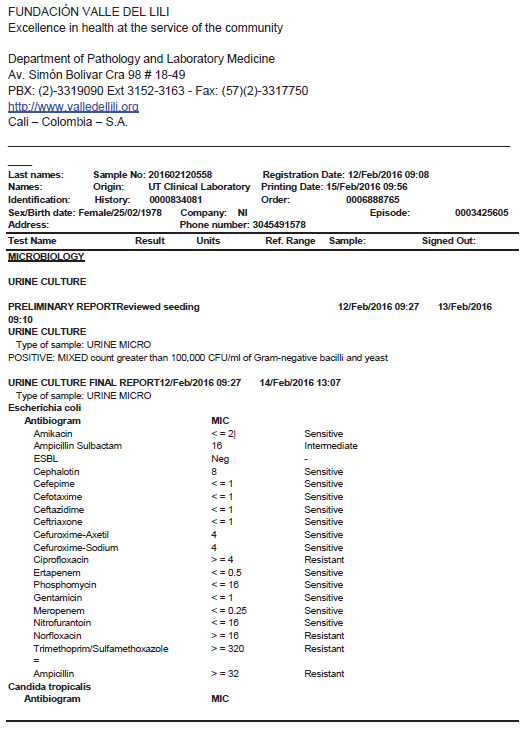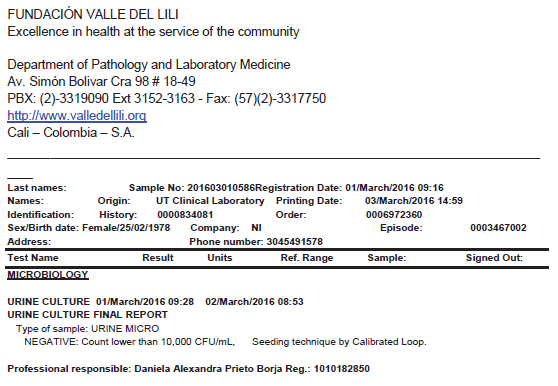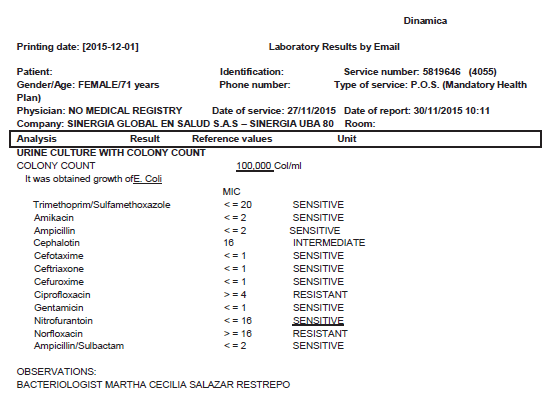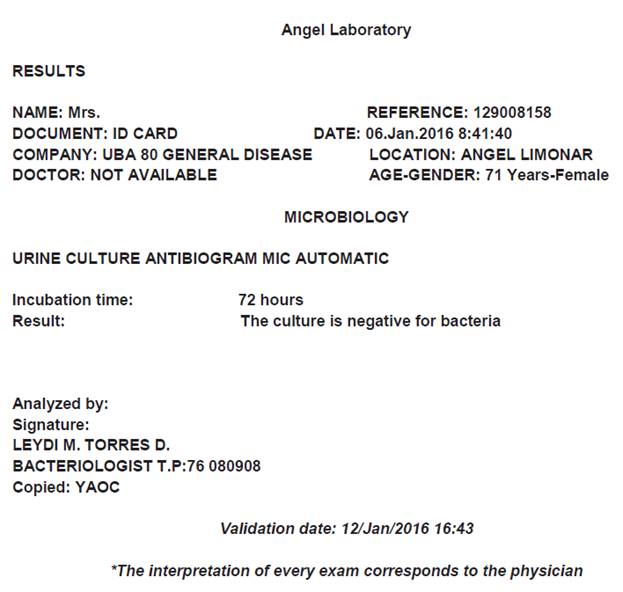Introduction
The development of antibiotics for the treatment of infections has been revolutionary in the impact on morbidity and mortality. However, bacteria learn quickly and generate increasingly effective alternatives to resist them. That happens, among other cases, with urinary infection due to E. Coli: antibiotics that in other times were as effective as ciprofloxacin, today generate induction of a third plasmid and induce a fearsome multi-drug resistance.1 Historically, this type of challenges have been resolved through the generation of more potent antibiotics and, without a doubt, much more expensive. For this reason, below we present an alternative brought from homeopathic medicine, a case in which the drug CANTHARIS 9 CH 5, sublingual globules, is used three times a day for fifteen days. It should be mentioned that, in the indexed literature, there is only one bibliographic reference that presents this alternative as an option for prophylactic treatment in humans.2
CANTHARIS 9 CH is obtained from the insectfrom which its name comes, similar to the "pitos", commonname "Spanish fly". In the procedure, the extract, composed of electrolytes, mainly phosphates, uric acid and cantharidin is taken from the dissected whole fly. The latter component is directly related to its therapeutic action.3
Case 1 presentation
A 37-year-old female patient with a history of two episodes of urinary infection, the last one five months ago, treated with cranberry and oral ciprofloxacin (in addition to positive factor V Leiden and polycystic ovary).She consults for a clinical picture of five days of severe dysuria and hematuria, managed with cranberry. Without improvement, a urine culture is requested and homeopathic management is initiated with CANTHARIS 9 CH 5, sublingual globules, three times a day for fifteen days. The urine culture is later reported as positive for E. Coli, more than 100,000 colonies, with resistance to norfloxacin, ciprofloxacin, T/ sulfa and indeterminate for ampicillin/sulbactam, with sensitivity to cephalosporins, nitrofurantoin, carbapenems and aminoglycosides (Figure 1).
The symptoms of the patient improved 24 hours after the initiation of therapy and the control urine culture seeded fifteen days after having suspended homeopathic treatment, was negative. The patient did not report any symptom or side effect during the time she took the treatment (Figure 2).
Case 2 presentation
A 72-year-old female patient who consulted for changes in the color of the urine and a history of recurrent urinary tract infections. It was taken a urine culture which resulted positive for E. coli, resistant to Ciprofloxacin and Norfloxacin, indeterminate for cephalexin, and sensitive to other cephalosporins, nitrofurantoin, T/sulfa, and aminoglycosides (Figure 3). Homeopathic management was started with CANTHARIS 9 CH 5, sublingual globules, three times a day for fifteen days. The urine culture taken 21 days after the end of treatment was negative (Figure 4). No symptoms and/or side effects were reported during the time the patient took the treatment.
Discussion
In this sample, with the use of CANTHARIS 9 CH the patients showed a good clinical response, negativized the urine cultures and did not manifest side effects. Besides the present, there are no reports in the indexed literature on the use of the homeopathic medicine Cantharis for the treatment of urinary infection in humans. There is only one case report in which it was used as a prophylactic agent for a long time and no side effects were reported. For this reason, it is recommended to conduct a prospective multicenter study that presents more statistical possibilities, such as the specific cytochemical variables to determine the possible non-symptomatic systemic toxicity
Conclusion
This study presents a new therapeutic opportunity besides the known antibiotic spectrum; it contributes a novelty to the literature, since there are no publications that show this alternative as therapeutic in urinary tract infections and, finally, secondary effects are not identified in the case reports.
Ethical responsibilities
Protection of people and animals
The authors declare that no experiments were performed on human beings or animals for this research.
Data confidentiality
The author declares that has followed the protocols of their workplace on the publication of patient data.
Right to privacy and informed consent
The authors state that patient data do not appear in this article.











 texto en
texto en 






